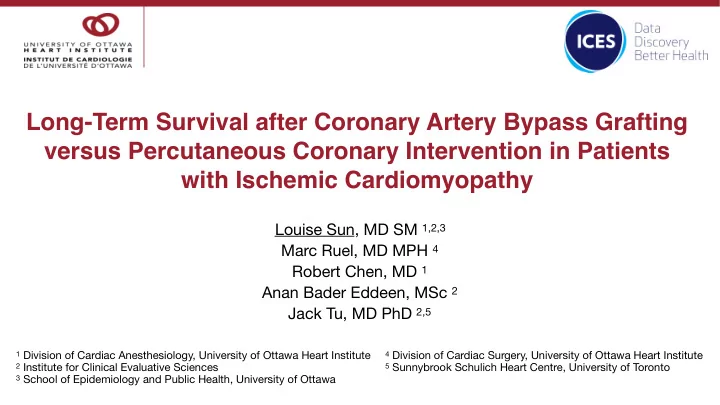

Long-Term Survival after Coronary Artery Bypass Grafting versus Percutaneous Coronary Intervention in Patients with Ischemic Cardiomyopathy Louise Sun, MD SM 1,2,3 Marc Ruel, MD MPH 4 Robert Chen, MD 1 Anan Bader Eddeen, MSc 2 Jack Tu, MD PhD 2,5 1 Division of Cardiac Anesthesiology, University of Ottawa Heart Institute 4 Division of Cardiac Surgery, University of Ottawa Heart Institute 2 Institute for Clinical Evaluative Sciences 5 Sunnybrook Schulich Heart Centre, University of Toronto 3 School of Epidemiology and Public Health, University of Ottawa
Background • Ischemic cardiomyopathy (ICM) • #1 cause of death globally • #1 cause of heart failure (HF) in the developed world • No head to head comparison of percutaneous coronary intervention (PCI) and coronary artery bypass grafting (CABG) in randomized trials • International guidelines differ with regards to recommended strategies • Safety of CABG has improved since the STICH era • PCI has developed as a contender, with therapeutic potential in ICM
Objective • To compare the outcomes of revascularization with PCI and CABG in patients with ICM. • Definition of ICM: • LVEF ≤ 35%, with one of the following: • ≥ 50% stenosis in the LM, ≥ 70% in the LAD territory, or ≥ 70% stenosis in ≥ 2 vessels
Methods Design: Population-based, retrospective cohort study in Ontario Inclusion: •Ontario residents aged 40-85 years •ICM •PCI or isolated CABG between October 1 2008 - March 31 2016 Exclusion: •Hybrid CABG and PCI within the same hospital admission •Emergent procedure (within 24 hours of acute MI) •Dialysis dependence, metastatic malignancy
Methods Exposure: PCI vs. CABG Primary Outcome: All-cause mortality Secondary Outcomes: MI, repeat revascularization, HF hospitalization Statistical Analysis: •Mortality assessed through December 31, 2017 • Mortality rate calculated using the Kaplan-Meier method • Multivariable Cox proportional hazard model •Secondary Outcomes: cause-specific hazard models (death = competing risk)
Methods Data Source: •CorHealth Ontario Clinical Registry Network of 20 hospitals that perform invasive cardiac procedures in Ontario • •Registered Persons Database (RPDB) Vital statistics • •Canadian Institute for Health Information (CIHI) Discharge Abstract Database: hospitalizations, comorbidities • Same Day Surgery Database: comorbidities • •Ontario Health Insurance Plan (OHIP) Physician service claims •
Results • 11,916 patients were included in the study • Mean follow up time = 4.5±2.5 years
Table 1. Baseline characteristics in patients who underwent CABG vs. PCI Variable PCI CABG P-Value N=7,147 N=4,769 Age Mean ± SD 65.6 ± 10.9 65.7 ± 9.7 0.89 Female 1,852 (25.9%) 821 (17.2%) <.001 Rural Residence 841 (11.8%) 763 (16.0%) <.001 Income Quintile 1 (Lowest) 1,511 (21.1%) 1,034 (21.7%) 0.99 2 1,491 (20.9%) 990 (20.8%) 3 1,474 (20.6%) 976 (20.5%) 4 1,379 (19.3%) 913 (19.1%) 5 (Highest) 1,247 (17.4%) 825 (17.3%) Morbid Obesity 1,781 (24.9%) 1,504 (31.5%) <.001 Hypertension 5,672 (79.4%) 4,216 (88.4%) <.001 MI within 30 days 5,511 (77.1%) 2,927 (61.4%) <.001 MI within 90 days 5,602 (78.4%) 3,067 (64.3%) <.001 Previous PCI 1,700 (23.8%) 646 (13.5%) <.001 Previous CABG 945 (13.2%) 64 (1.3%) <.001 HF 3,215 (45.0%) 2,648 (55.5%) <.001 Atrial Fibrillation 547 (7.7%) 324 (6.8%) 0.078
Table 1. Baseline characteristics in patients who underwent CABG vs. PCI Variable PCI CABG P-Value N=7,147 N=4,769 CVD 579 (8.1%) 521 (10.9%) <.001 PVD 721 (10.1%) 736 (15.4%) <.001 COPD 2,325 (32.5%) 1,576 (33.0%) 0.56 Diabetes 3,252 (45.5%) 2,646 (55.5%) <.001 Hypothyroidism 128 (1.8%) 97 (2.0%) 0.34 Liver Disease 58 (0.8%) 36 (0.8%) 0.73 Alcohol Abuse 146 (2.0%) 135 (2.8%) 0.005 Anemia 588 (8.2%) 740 (15.5%) <.001 Renal Disease 217 (3.0%) 184 (3.9%) 0.02 Paraplegia 34 (0.5%) 14 (0.3%) 0.08 Primary Malignancy 340 (4.8%) 240 (5.0%) 0.49 Dementia 39 (0.5%) 19 (0.4%) 0.26 Depression 152 (2.1%) 111 (2.3%) 0.47 Psychosis 19 (0.3%) 22 (0.5%) 0.07 Charlson Index Mean ± SD 2.4 ± 1.7 2.7 ± 1.7 <.001
Figure 1. Adjusted Kaplan-Meier survival curves by revascularization strategy 1.00 0.95 0.90 0.85 0.80 Long-Term Survival 0.75 CABG 0.70 0.65 0.60 PCI 0.55 0.50 0.45 0.40 0.35 0.30 0 1 2 3 4 5 6 7 8 9 Time (Years)
Results • 11,916 patients were included in the study • Mean follow up time = 4.5±2.5 years PCI CABG Adjusted HR (95% CI) Outcome (N=4,769) (N=7,147) (CABG vs. PCI) Long-Term Survival 5,101 (71.4%) 3,596 (75.4%) 0.63 (0.58-0.68) MI 1,404 (19.6%) 292 (6.1%) 0.31 (0.27-0.35) Revascularization 1,701 (23.8%) 268 (5.6%) 0.28 (0.25-0.31) HF Hospitalization 1,537 (21.5%) 953 (20.0%) 0.79 (0.72-0.86)
Conclusion • In patients with ICM, CABG was associated with a lower adjusted risk of long-term mortality compared to PCI, despite CABG patients having a higher burden of comorbidities. • Impetus for clinical trial. • Further research is needed to evaluate the comparative effectiveness of PCI versus CABG in the quality of life in patients with ICM.
Thank you!
Table 2. Multivariable predictors of long-term mortality Variable HR (95% CI) 0.63 (0.58-0.68) CABG vs. PCI Age Reference 40-64 1.80 (1.63-1.98) 65-74 75-84 3.06 (2.77-3.37) 0.91 (0.84-1.01) Female 1.04 (0.93-1.15) Rural Residence Income Quintile 1.22 (1.08-1.38) 1 (Lowest) 1.12 (0.99-1.27) 2 1.08 (0.95-1.22) 3 4 1.05 (0.93-1.19) Reference 5 (Highest) 1.04 (0.95-1.15) Morbid Obesity 1.08 (0.95-1.23) Hypertension 1.32 (1.21-1.44) MI within 30 days of surgery 1.30 (1.19-1.42) Remote MI
Table 2. Multivariable predictors of long-term mortality Variable HR (95% CI) 0.85 (0.77-0.95) Previous PCI 0.96 (0.46-2.02) Previous CABG 1.99 (1.83-2.17) CHF 1.35 (1.21-1.52) Atrial Fibrillation CVD 1.22 (1.09-1.37) 1.58 (1.43-1.74) PVD 1.28 (1.18-1.38) COPD 1.35 (1.25-1.46) Diabetes 0.99 (0.79-1.25) Hypothyroidism 1.50 (1.10-2.04) Liver Disease 1.20 (0.96-1.49) Alcohol Abuse 1.37 (1.24-1.52) Anemia 1.58 (1.36-1.84) Renal Disease 1.30 (0.85-1.98) Paraplegia 1.48 (1.29-1.70) Primary Malignancy 0.86 (0.59-1.25) Dementia 1.21 (0.98-1.50) Depression 1.30 (0.75-2.24) Psychosis
Recommend
More recommend